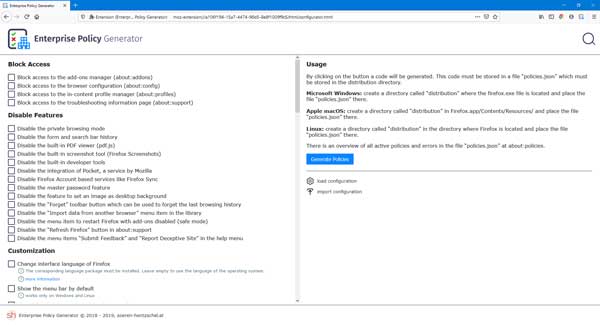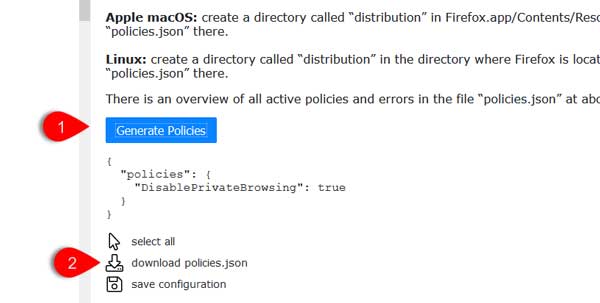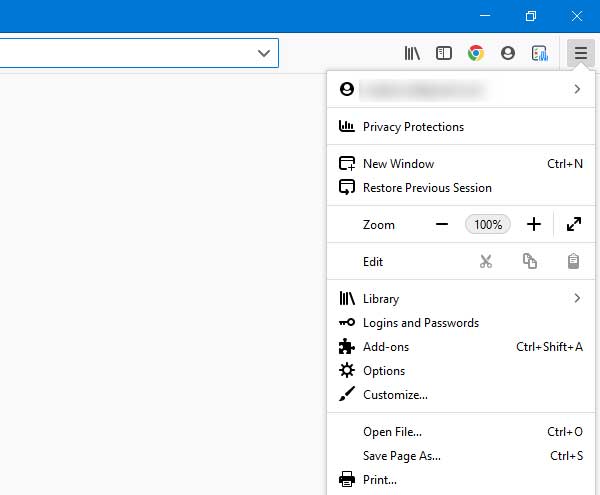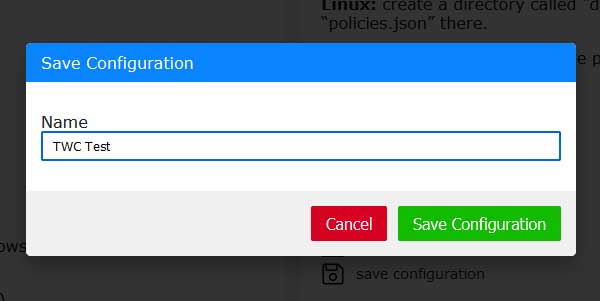If you are using the Firefox browser, and you want to block other users from using some settings, features, options, etc., then you can install a Firefox add-on called Enterprise Policy Generator. It will let you temporarily disable or block Firefox settings by generating a policy that prevents various functionalities of the Firefox browser.
Let’s assume that you are giving your computer to your child for some time, and you do not want to allow him/her to disable or uninstall any add-on. You can block your child from opening the corresponding page, and thus, he/she won’t be able to make any changes. Similarly, you can apply different policies on different computers in different places, such as school, home, office, etc.
Enterprise Policy Generator for Firefox
The Enterprise Policy Engine addon allows administrators to configure Firefox via a configuration file. To create a policy, you need to follow these steps-
- Install Enterprise Policy Generator
- Create policy using the add-on
- Place the .json file in the installation directory
- Restart the Firefox browser.
Open the Firefox browser and install the Enterprise Policy Generator add-on from the official repository. After installing it, you can find a new icon next to the address,ss bar. If you click this icon, you will open a window where all the options are present.

You can choose what you want to block or disable.
To select, make a mark in the desired checkbox. If you are done with the selections, you need to click the Generate Policies button.
You will find the policy on your screen.
You have to now download the .json file by clicking the download policies.json button.

After saving the file, open the Firefox installation directory which will typically be at this path-
C:\Program Files\Mozilla Firefox
In the Firefox folder, you need to create a sub-folder and name it as distribution. Following that, paste the policies.json file in this “distribution” folder.
After that, restart your browser to make the change.
Example 1 – Disable the private browsing mode

Let’s assume that you want to disable the private browsing mode of your browser. For that, open the Enterprise Policy Generator’s panel and make a tick in the checkbox saying Disable the private browsing mode under the Disable Features section. Then, you need to click the Generator Policies button, save the .json file, move it to the distribution folder, and restart your browser. After restarting, you cannot find the New Private Window option on the menu. Check the following image where “New Private Windows” is no longer visible.
Even if you press Ctrl+Shift+P, it won’t open the private mode.
Example 2 – Set and lock the download directory
Let’s assume that you want to set a specific folder as the default download directory and lock it so that others cannot change it in any way. At this time, you need to make a tick in the checkbox saying Set and lock the download directory and enter a directory that you want to set as default.
Following that, follow the same steps to apply the change.
Save and import configuration
If you need to change the filters frequently, you can save a set of configurations and load them whenever needed. For that, you need to select all the policies that you want to apply, click Generate Policies, and save configuration buttons accordingly. After clicking this button, it will ask you to enter a name.

Do that, and click the Save Configuration option. If you want to get a particular set of configurations, you can click the load configuration button, and select something from the list. Then, you need to follow the same steps to apply the filters.
How do I turn off enterprise policy in Firefox?
To turn off enterprise policy or roots in Firefox, you need to open the browser, enter about:config and hit the Enter button. Accept the terms and search for enterprise. Find the security.certerrors.mitm.auto_enable_enterprise_roots setting and check if the value is set to false or not. If not, you need to double-click on this setting to make it false.
How do I control Firefox with Group Policy?
In order to control Firefox with Local Group Policy Editor, you need to install the GPEDIT template for Firefox browser first. Then, open the Local Group Policy Editor and navigate to Computer Configuration > Administrative Templates > Firefox. Here you can find all the settings that you can change as per your requirements.
For your information, you can add multiple policies in a single .json file. If you like this add-on, you can download it from the mozilla.org page.
Leave a Reply